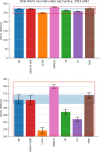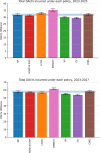A new approach to Health Benefits Package design: an application of the Thanzi La Onse model in Malawi
- PMID: 39348389
- PMCID: PMC11567512
- DOI: 10.1371/journal.pcbi.1012462
A new approach to Health Benefits Package design: an application of the Thanzi La Onse model in Malawi
Abstract
An efficient allocation of limited resources in low-income settings offers the opportunity to improve population-health outcomes given the available health system capacity. Efforts to achieve this are often framed through the lens of "health benefits packages" (HBPs), which seek to establish which services the public healthcare system should include in its provision. Analytic approaches widely used to weigh evidence in support of different interventions and inform the broader HBP deliberative process however have limitations. In this work, we propose the individual-based Thanzi La Onse (TLO) model as a uniquely-tailored tool to assist in the evaluation of Malawi-specific HBPs while addressing these limitations. By mechanistically modelling-and calibrating to extensive, country-specific data-the incidence of disease, health-seeking behaviour, and the capacity of the healthcare system to meet the demand for care under realistic constraints on human resources for health available, we were able to simulate the health gains achievable under a number of plausible HBP strategies for the country. We found that the HBP emerging from a linear constrained optimisation analysis (LCOA) achieved the largest health gain-∼8% reduction in disability adjusted life years (DALYs) between 2023 and 2042 compared to the benchmark scenario-by concentrating resources on high-impact treatments. This HBP however incurred a relative excess in DALYs in the first few years of its implementation. Other feasible approaches to prioritisation were assessed, including service prioritisation based on patient characteristics, rather than service type. Unlike the LCOA-based HBP, this approach achieved consistent health gains relative to the benchmark scenario on a year- to-year basis, and a 5% reduction in DALYs over the whole period, which suggests an approach based upon patient characteristics might prove beneficial in the future.
Copyright: © 2024 Molaro et al. This is an open access article distributed under the terms of the Creative Commons Attribution License, which permits unrestricted use, distribution, and reproduction in any medium, provided the original author and source are credited.
Conflict of interest statement
The authors have declared that no competing interests exist.
Figures






References
-
- The World Bank. World Development Report 1993: Investing in Health; 1993. Available from:https://openknowledge.worldbank.org/entities/publication/cfc6265c-8fc7-5....
-
- Ministry of Health of Ethiopia. Essential Health Services Package of Ethiopia. Addis Ababa, Ethiopia; 2019. Accessed on 22/04/24. Available online athttps://www.uib.no/sites/w3.uib.no/files/attachments/essential_health_se....
MeSH terms
Grants and funding
LinkOut - more resources
Full Text Sources
Medical
Miscellaneous

